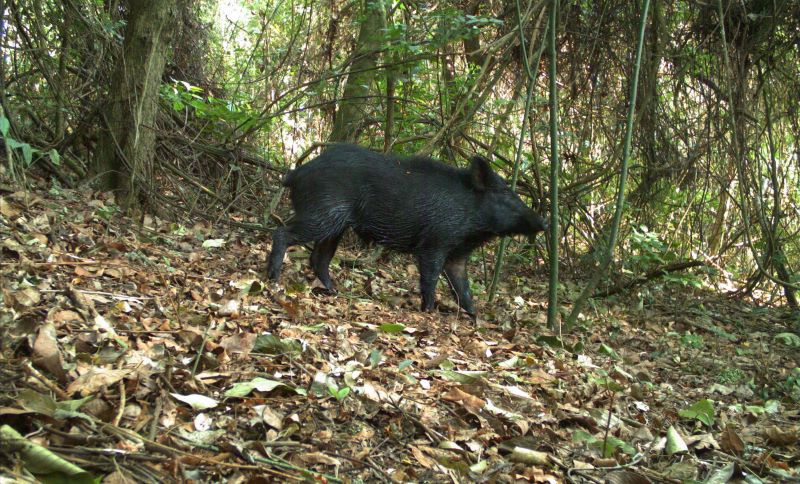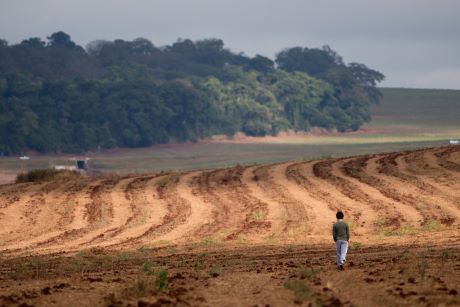


A boar in an area of Cerrado in the northeast of São Paulo state. These exotic mammals are classed as pests, preying on crops and forcing out native species. They are more plentiful in areas of monoculture with scant native vegetation (photo: Ecology and Conservation Laboratory/LAEC-FFCLRP-USP)
Published on 02/05/2024
By André Julião | Agência FAPESP – There are no substitutes for native vegetation, but replacing large areas of monoculture with diversified crops in places where agricultural activities are widespread can have beneficial effects on the mammals that still inhabit the region.
This is one of the conclusions of a study conducted by researchers at the University of São Paulo (USP) supported by FAPESP. They focused on the northeast of São Paulo state, where the predominant biome is the Cerrado (Brazilian savanna). The region is one of the nation’s agribusiness centers.
An article on the study is published in the Journal of Applied Ecology. The study showed that land use conversion from extensive monoculture – the practice of growing a single crop over a large area – to diversified crops helped control invasive species that cause damage to farmers, such as the Wild boar (Sus scrofa).
The researchers analyzed the presence of native and exotic mammals in nine sampling sites across 55 units of 200 hectares (landscapes) – three in agricultural areas and six in native vegetation remnants. Plant cover was identified in patches of 3,000 hectares surrounding each unit. Altogether, the study area totaled 34,000 square kilometers touching on 80 municipalities in São Paulo state.
Data collected at each of the sites in 2017 and 2018 focused on tracks left by mammals, including footprints, droppings and other signs. The researchers also installed cameras in areas of native vegetation.
“The composition of these landscapes was more or less heterogeneous, with a mixture of native vegetation, monoculture and various crops. We looked for correlations between the degree of heterogeneity and the presence or absence of native and exotic mammals,” said Marcella do Carmo Pônzio, first author of the article. She is currently a PhD candidate at the Institute of Biosciences (IB-USP).
The impact of heterogeneity on the landscape was equivalent to 80% of the effect of areas of Cerrado in the region on the number of native species in that context. Furthermore, diversification of plant cover reduced the number of invasive species, such as boars, by 27%.

An area of monoculture with native vegetation in the background: continuous hectares of crops such as sugarcane are most harmful to wildlife and ecosystem services (photo: Adriano Chiarello/FFCLRP-USP)
“Although more sensitive species, such as the Jaguar [Panthera onca], have disappeared, greater landscape complexity can mean more mammals belonging to native species, such as the Puma [Puma concolor] and the Giant armadillo [Priodontes maximus], for example, and fewer belonging to invasive species. In areas of monoculture with little native vegetation, on the other hand, boars predominate,” Pônzio said. She obtained part of the results while she was a researcher at the Ribeirão Preto School of Philosophy, Sciences and Letters (FFCLRP-USP) with a scholarship from FAPESP.
The study was part of the project “Occurrence of mammals and biological invasion in Cerrado remnants of agricultural landscapes”, supported by FAPESP. The principal investigator for the project was Adriano Garcia Chiarello, a professor at FFCLRP-USP and Pônzio’s supervisor for her master’s research.
“Most properties in the study area don’t even comply with the Forest Code,” Chiarello said, referring to a federal law that requires conservation of 20% of the native vegetation in properties in the Cerrado, in addition to river banks and hills, which are classed as Permanent Protection Areas (Portuguese-language acronym APPs).
Even if the owners of these areas complied with the rule, he added, 20% is not sufficient for wildlife to survive and for maintenance of ecosystem services such as water supply, carbon storage and climate regulation.
Although this was not the focus for the study, research by other groups has shown that at least 35%-40% of the native vegetation should be conserved in order to maintain biodiversity and ecosystem services.
Diversification
As expected, the existence of native vegetation was the factor that most influenced native mammal richness, defined as the number of individuals recorded across the nine sites per landscape. The species observed include P. concolor and the Maned wolf (Chrysocyon brachyurus).
These species are generalists, however, and more adaptable to degraded areas. Mammals that have historically inhabited the Cerrado, such as P. onca, P. maximus and the Peccary (Tayassu pecari), have become locally extinct.
Native vegetation was also the factor that most influenced reductions in numbers of invasive species, such as the Domestic dog (Canis lupus familiaris), the European hare (Lepus europaeus), and above all S. scrofa, which in Brazil is a hybrid species that was originally introduced by breeders. Boars are considered an agricultural pest, as they are omnivorous and eat many crops and other plants. The study detected them mostly in areas with monocultures such as sugarcane and little native vegetation.
The good news amid all this degradation and species loss was that crop diversification mitigated the effects of a lack of native vegetation. In other words, native species richness was supported in agricultural areas with more diversified plant cover, such as family farms and other properties that focus on food production, as well as integrated crop-livestock-forestry systems, and exotic species tended to be kept out of such areas.
“The findings suggest that policymakers should perhaps not focus solely on halting deforestation but should also combat simplification of the landscape. Even more than deforestation, we need to concern ourselves with what is done in areas that were once Cerrado,” said Renata Pardini, last author of the article. She is a professor at IB-USP and Ponzio’s PhD thesis advisor.
As a positive model, Pardini cited Refloresta-SP, a program coordinated since 2022 by the São Paulo State Department of Environment, Infrastructure and Logistics to restore degraded ecosystems and areas, develop multifunctional forests and implement agroforestry systems with the aim of promoting economic as well as ecological improvements.
Native species are used in conjunction with non-native species to generate income for farmers and assure the provision of important ecosystem services even for traditional cropping systems. The program involves a partnership with BIOTA Synthesis, a Science for Development Center funded by FAPESP and hosted by USP. Both Pônzio and Pardini are members (read more at: agencia.fapesp.br/38760).
The researchers stress the importance of maintaining and creating legally protected areas of Cerrado in São Paulo state, where native vegetation is found in only 20% of the region. In the study area, for example, the largest protected area is the Jataí Ecological Station, with only 9,075 hectares.
“We don’t suppose diversified agriculture would offset the environmental damage done by deforestation and monoculture. Our data shows it’s important but no substitute for the role of native vegetation,” Pônzio said.
The study was also supported by FAPESP via a doctoral scholarship and a research internship at Colorado State University in the United States awarded to Nielson Pasqualotto.
The other co-author of the article is Marina Zanin, a researcher at IB-USP who at the time of the study was supported by FAPESP via a postdoctoral scholarship.
The article “Landscape heterogeneity can partially offset negative effects of habitat loss on mammalian biodiversity in agroecosystems” is at: besjournals.onlinelibrary.wiley.com/doi/full/10.1111/1365-2664.14543.
Source: https://agencia.fapesp.br/50791